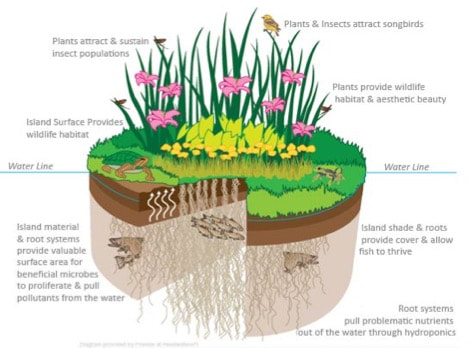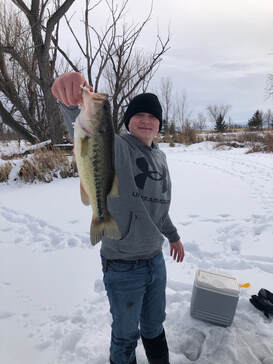BioHaven Technology is the Gold Standard of Floating Treatment WetlandsIn 2005, when BioHaven Floating Island technology came to the attention of eminent wetland scientist Dr. Chris Tanner, he heralded them as the “new generation” of floating treatment wetlands. Tanner immediately began a research program to measure their ability to remove nutrients and heavy metals from stormwater. His success sparked over a decade of BioHaven research at leading universities and institutes around the world.
|
What Makes BioHavens Different?
- BioHaven matrix is a highly-technical, engineered substrate, made from the highest-grade materials, to form a resilient attachment surface for biofilm - a bioreactor.
- The matrix structure is a perfect plant-growing platform, allowing perennial plants to fully mature and be effective over many years without reaching a performance plateau.
- Our proprietary sizing tool can accurately estimate the amount of BioHaven needed to meet water quality goals.
- They are a quasi-hydroponic system that uses a growing medium to supply plants with nutrition that does not leach into the water.
- Oxygen is allowed to permeate the upper layers to benefit plant growth, while below the waterline, biofilm covers every fiber.
- The permeable matrix, even when coated in biofilm, does not plug up.
- Plants, plant roots and BioHaven matrix combine to perform a vast surface area for biofilms to attach to as the optimal pathway for removal.
- Their internal buoyancy provides depth and rigidity, making them extremely robust.
- They are scalable in length, width and depth to meet the demands for small and large system sizing, suitable for use in any waterbody.
Nature’s Wetland Effect
Nature’s Wetland Effect is a term we use to describe why BioHavens are so effective: they biomimic the processes of a natural wetland – hence “Nature’s Wetland Effect". We break these processes down to two primary components – surface area and circulation.
Floating Islands – or Floating Treatment Wetlands (FTWs) as they are also called – provide a massive amount of surface area.
First, the BioHaven matrix has a high surface-area to footprint ratio. Second, the plants contribute an enormous amount of surface area, within the island and below it.
Surface area is important because it promotes the growth of biofilm communities which are composed of massive numbers of the different microbes responsible for cleaning water. Biofilms are more resilient and reproduce faster than free-swimming microbes. And, en masse, they excrete a sticky substance called EPS (Extra-cellular Polymeric Substance) that traps fine particles and promotes water clarity and digestion. We would go so far as to say this EPS traps microplastics, which is being researched at present.
“Concentrated Wetland Effect” is related. It reflects the fact that a BioHaven Floating Island has all its surface area in the water column, as opposed to other types of constructed wetland where the plants are rooted into the ground or sediments.
Circulation can be natural – the path that water takes from inflow to outflow in a pond or lake provides natural circulation – or forced, helped along by a mechanical system, which might also provide aeration. The BioHaven StreamBed is an example of a BioHaven that provides both surface area and circulation in a single unit. We are currently testing nanobubble aeration technology on our floating islands.
Surface area is important because it promotes the growth of biofilm communities which are composed of massive numbers of the different microbes responsible for cleaning water. Biofilms are more resilient and reproduce faster than free-swimming microbes. And, en masse, they excrete a sticky substance called EPS (Extra-cellular Polymeric Substance) that traps fine particles and promotes water clarity and digestion. We would go so far as to say this EPS traps microplastics, which is being researched at present.
“Concentrated Wetland Effect” is related. It reflects the fact that a BioHaven Floating Island has all its surface area in the water column, as opposed to other types of constructed wetland where the plants are rooted into the ground or sediments.
Circulation can be natural – the path that water takes from inflow to outflow in a pond or lake provides natural circulation – or forced, helped along by a mechanical system, which might also provide aeration. The BioHaven StreamBed is an example of a BioHaven that provides both surface area and circulation in a single unit. We are currently testing nanobubble aeration technology on our floating islands.
Water Clarity
Sunlight is one of the primary drivers of the aquatic food web but cloudy water blocks out the sun. BioHavens provide water clarity by filtering out the suspended solids (TSS), and they make a difference as soon as they are installed. They filter the tiniest particles, including heavy metals and clay particles that are very challenging to remove from water. The key is to position the islands to take best advantage of natural or mechanical circulation, so that the solids are brought into direct contact with the biofilms on the root biomass.
But sunlight can trigger growth of aquatic plants as well. If BioHavens are present in the water, competing for nutrients, the plant growth can be managed. Some aquatic vegetation (say, 40%) is good for the system, if the plant species are native and perennial. BioHavens can shade out undesirable aquatic plants if positioned above them.
How Does Ice Affect BioHavens?
BioHavens winterize very well. In cold climates, water freezes in and around the matrix, which is flexible enough to handle any expansion caused by ice. It is not uncommon to experience situations where, during a long winter, islands freeze, seasonal water levels may recede under the ice and the ice breaks, taking the islands with it. Then it snows, rains, thaw and freezes again, often causing the islands to be buried under several feet of snow. Finally, when Spring thaw arrives, the islands regain their buoyancy and the plants grow again (at least, if you've planted perennials) and become the lush and beautiful islands you remember from last Fall.
|
BioHavens will survive most winter conditions. If you wish to deploy them in a lake with moving ice, it is important to design around this condition.
During winter, fish are very susceptible to both cold temperatures and low dissolved oxygen in the water. To avoid freezing, they inhabit the bottom layer of the water, when it is stratified. However, this is the zone that typically has the least oxygen and the most sediment. One big advantage of our newly-developed NanoHaven is that it gently adds concentrated oxygen to the bottom layer without stirring up the sediments, so that fish can breathe and survive the toughest time of year. A fish that is healthy going into Spring has a much better chance of successful breeding and overall survival. |
How Much BioHaven Do I need?
Using our extensive portfolio of case studies, our proprietary modeling tool can compare your current situation with our historical performance data and extrapolate the amount of BioHaven needed to meet your goals. Our model is based on flow-rate and current water quality input parameters / goals. The more information you can give us, the more accurate our estimate will be. If you don't have a lot of information, don't worry: we can do estimates based on percent coverage and, of course, your budget. Our very basic premise is that one island is always better than no island.
For a detailed look at how our modeling system works, please request our modeling paper.
For a detailed look at how our modeling system works, please request our modeling paper.
Our Expertise
|
Floating Island International has partnered with biofilm engineers and plant scientists to bring a best-in-class approach to nutrient management and water resource recovery. Our engineers are graduates and associates of Montana State University’s world-class Center for Biofilm Engineering and fully understand the water remediation and recovery environment. Our plant specialists are experts in choosing hyper-accumulator plants and microbes for the best possible phyto-remediation results in aquatic settings.
|
Water Resource Recovery Pathways
For a full discussion on the removal mechanisms of floating treatment wetlands, please call us to request our Pathways Reports.
Case StudiesTo verify the efficacy of our products and to enable comprehensive sizing of new projects, FII and partners conduct extensive field testing. Project results are published in FII case studies. Our case studies are unique to BioHaven technology and do not correlate with any other floating wetland system.
|
Research Papers
Floating Island International, Inc. and its licensees are heavily invested in academic research. Here you will find research reports and peer-reviewed papers demonstrating and quantifying the efficacy of BioHaven Floating Islands.
|


